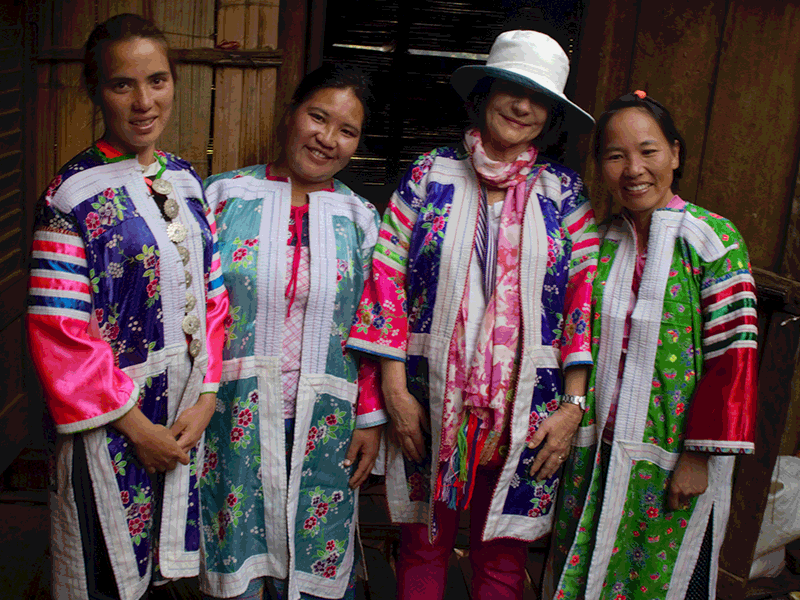As the world celebrated the rescue of 12 trapped boys and their soccer team coach from caves in northern Thailand (while mourning the loss of one of their brave rescuers) last summer, I found myself immersed in memories of visiting this region for more than 30 years. In news coverage of the unfolding drama, I recognized—among Thai Navy Seals, officials, foreign divers, frantic parents—women clad in the tribal dress of the Lisu and Lahu mountain peoples.
This is the Golden Triangle, where the borders of Thailand, Myanmar and Laos meet, and where ethnic minorities–Lisu, Lahu, Akha, Karen, and more—eke out an existence as hill farmers. Recently my Lisu “niece” wrote to say her mother and other villagers were concerned for the trapped kids, wondering if traditional offerings to the cave spirit would help free them.
READ: A PASSAGE TO BANGKOK AND BEYOND
Indeed, one of the now-famous rescued children – the only one who spoke English – is a “stateless” refugee from Myanmar, a member of the Wa ethnic minority; his coach, orphaned at age 10, belongs to the Shan minority, and, as is customary with poor kids, was sent to a Buddhist Temple to be housed and educated. Stories like these open windows onto this very diverse part of the world.
Decades back, in mountainous Chiang Rai province, I first visited the village of Doi Laan, where I met the little girl who would become my Lisu “niece.” Dark-eyed Mimi, a tiny thing standing on a dirt path, was nevertheless familiar. I recognized her dress; it had been a favourite of my own daughter’s. Since an anthropologist friend had settled here, I’d been sending her boxes of children’s clothes and other supplies. All grown up now, Mimi fondly calls me “Auntie,” in the way of the east.

During our most recent visit to northern Thailand, a black SUV pulled into the parking lot of our rented condo in the tourist-friendly city of Chiang Mai, several hours south of the mountains. “Good morning Auntie!” Mimi called excitedly as we climbed aboard. At the helm of the rental van sat Mimi’s boyfriend, Joe, visiting from Myanmar. With shoulder-length hair and an easy manner, Joe’s musical tastes ran to Top 40 hits from the 70s and 80s that became the soundtrack to our day trip.
After a two-hour drive north on a smooth highway, Joe pulled into a spanking new plaza to gas up. At a café, we ordered locally grown coffee. Cappuccino in hand, I remembered my first visit to the Golden Triangle, three decades back.
A hired Jeep had dropped my anthropologist friend and I at a gathering point, where we chatted with tribes people and European trekkers, until a truck took us up the steep unpaved road to the Lisu village Doi Laan (“See-the-Tiger”) where she was researching her book on this mountain group.
In a region famed for its opium – a cash crop banned in 1984 – farmers were struggling with replacement crops, like tomatoes. Lodging in her thatched bamboo hut, sipping Nescafé by a smoky wood fire, I shared meals with Mimi’s grandparents, and was dazzled by mountain vistas by day and starry canopies by night. Before sleeping, I sealed my contact lenses in a baggie pegged on a clothesline, “so the rats won’t get them.” Mimi’s grandmother’s surprise parting gift – a handwoven purse –brought tears to my eyes. When divers from foreign countries recently spoke of local people’s generosity, I understood what just they meant.
Now, decades later, little Mimi speaks fluent English (plus Thai and Lisu), holds a master’s degree in ethnic minority studies from Chiang Mai University, has travelled to the U.S. on an ethnic studies program, and chatted with then-president Barack Obama on his Laos trip. Marrying her degree with her boundless energy, Mimi (with family and friends’ help) has built a Lisu Cultural Center in the city of Chiang Mai, a showcase for crafts, jewelry and history.

In the mountains, we found that homestays are increasingly popular. Today’s Doi Laan has sturdy housing and modern amenities, but no homestays – yet. In another mountain village, where foreign visitors can stay enjoy a night or two, we ducked into the wooden home owned by Sombat, a Lahu village elder. Some chatty Italians were just leaving; foreigners have long loved to wander these hills.
Under shafts of sunlight, we sat in a circle, sipping glasses of Chang beer. Beneath the floor, pigs snorted; outside, chickens strutted, roosters crowed, dogs lazed in the sun. Children played with hand-carved wooden slingshots. I admired woven shoulder bags hanging on a pole, so Sombat showed me the wares; I bought two singular (and inexpensive) pieces. Later we purchased a litre of mountain honey – among the world’s best. On this peaceful afternoon, it was easy to forget the hostility that met nomadic tribes from Myanmar, Tibet, and China in the 1920s, when they first settled permanently in these hills.
These days, coffee crops are meeting with success. One young Akha entrepreneur markets his people’s organic Arabica beans locally and internationally. Other projects have been championed by the Thai royal family – tea and strawberries are popular – along with traditional arts and crafts. As for opium, it has its own museum, in the town of Chiang Rai—although newer drugs remain dangerous.
After a lunch of rice, veggies, curries, salads, and a coriander-infused chili sauce, smart phones and iPads appeared; us ladies donned bright Lahu robes and posed happily in the sunshine. Afterward we trekked up the brick-red road twisting through the sleepy village, noticing a shiny motorbike, a smiling young mum holding her baby, and airy hillside houses perched on stilts. At the crest of the highest hill, we happened on the Royal Agricultural Research Station where two smiling Thai women sat behind their desks.
To western visitors, these villages can seem like summer camps in paradise. Still, few villagers have fared as well as our Mimi. Her parents sent their ambitious daughter to be educated at a Buddhist-run residential school in the south; she saw them just once a year until she graduated. In this way, her childhood rather resembles that of the English-speaking soccer player (and star student), sent to Thailand for an education by his parents in Myanmar.
Stories like these promise hope. Our gentle driver, Joe, was arrested with a dozen political friends and imprisoned for two years – but not tortured he assured us – under the Generals’ regime. Now he runs his own construction business in Yangon. Mimi’s youngest brother graduated with a degree in tourism development from Chiang Rai University; the siblings hope to open their own homestay in the mountain village where they were born.
On the winding road back to town, a disco version of Jambalaya blasted from Joe’s sound system. We all sang along.
To visit a hill tribe village, contact TourismThailand.org—their new guide to Royal Projects is full of interesting suggestions, including Homestays. For Huay Nay Rin, the Lahu village we visited, contact Jaffa Jahu (090-958-2903). No time for a mountain trip? Visit Mimi’s Lisu Culture and Heritage Center (80, Bamrungrat, soi 2, near Wat Ket), Chiang Mai. FB: LisuPatchwork-LisuCulturalHeritageCenter. [email protected]







